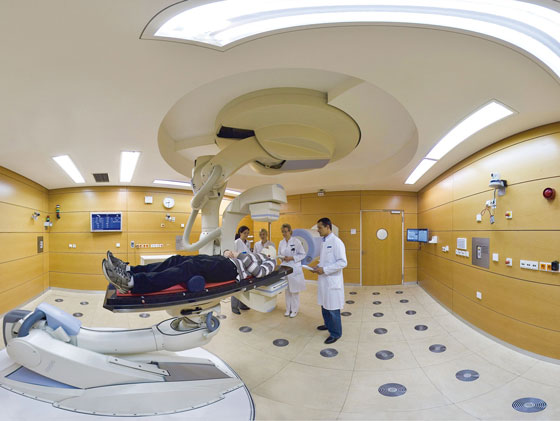New research makes cutting edge cancer treatment more precise
18 Feb 2017 by Simon Davies Radiation treatment in the Heidelberg Ion-Beam Therapy Center HIT. Photo: Heidelburg University Hospital
Radiation treatment in the Heidelberg Ion-Beam Therapy Center HIT. Photo: Heidelburg University Hospital
Researchers in Germany have taken an important step towards improving the accuracy of a highly effective radiotherapy technique used to treat cancer.
The team, from the German Cancer Research Centre (DKFZ), the Heidelberg Ion-Beam Therapy Centre (HIT) and the Physikalisch-Technische Bundesanstalt (PTB), hoped to address uncertainty about the dosimetry – the measurement and assessment of the absorbed radiation dose – for carbon ion beam therapy.
Their results, published in the journal Physics in Medicine and Biology, show they achieved a threefold reduction of the uncertainty related to the dosimetry of clinical carbon ion beams.
Senior author Professor Oliver Jäkel, from DKFZ and HIT, said: “Carbon ion therapy is a cutting-edge alternative to conventional radiotherapy, which can benefit patients with deep-seated or radiation-resistant tumours. However, owing to its complexity, its use is not widespread, despite it being around for more than 20 years.
“Contrary to the potential high precision of ion beams, the accuracy of the dosimetry for carbon ions has not, until now, been as accurate as that for conventional high-energy photon or electron beams. We hope this study will provide a means to overcome that particular hurdle.”
The research team performed measurements of the absorbed dose to water, using water calorimetry in the entrance channel of a scanned 6 cm x 6 cm radiation field of 429 MeV per nucleon carbon ions. This allowed them to directly calibrate ionization chambers, which are typically used in clinical dosimetry, and experimentally determine the beam quality-dependent kQ factor of the chambers.
Lead author Julia-Maria Osinga-Blättermann from PTB and DKFZ said: “Because of the lack of experimental data, up to now the kQ factor has been calculated. Our result proves that experimental kQ factors with small uncertainties can be used instead.
“Our detailed investigation of the radiation field allowed the accurate determination of correction factors needed for both calorimetric and ionometric measurements. Therefore, the experimental determination of the kQ factor for carbon ion beams was achievable with a relative standard measurement uncertainty of 0.8 per cent. This is about a threefold reduction of the uncertainty compared to calculated values, and thus allows us to significantly reduce the overall uncertainty related to ionization-based dosimetry of clinical carbon ion beams.”
Professor Jäkel said: “This technology has great promise for improved treatment of cancer due to the highly energetic particles used. Although our work is but one step, it is a significant one, reporting unprecedented accuracy in control of the dose of ions delivered. Ultimately, this will enable the radiation dose to cancerous tissue be maximised (leading to an improved treatment efficacy), whereas radiation dose to healthy tissue will be minimised, reducing the late effects of radiation to these tissues.”